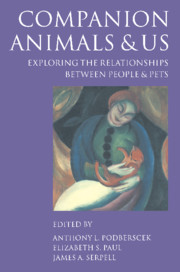Book contents
2 - The social significance of pet-keeping among Amazonian Indians
from Part I - History and culture
Summary
INTRODUCTION
The passionate relationship native lowland South Americans maintain with a wide array of pets has long been a favourite topic of chroniclers and scholars, such as Im Thurn (1882) and Guppy (1958), to name but two. Yet, its social significance and contrasted stance with regard to hunting have until now attracted surprisingly little attention.
Most studies devoted to native hunting in the neotropics emphasize the importance of predation in the symbolic universe of Amazonian peoples. Yet, despite its valorization as a key metaphor for social life, hunting, as a unilateral appropriation of wildlife, seems to clash with the great emphasis Amazonian ideology generally places on reciprocity. Along with its positive aspects, hunting therefore also engenders a kind of conceptual discomfort. A number of institutions (linked to shamanism, hunting ethic and hunting rites, prohibitions and so forth) tend to reduce the logical consequences of this imbalance. But these might not fully suffice to give ‘a good conscience’ to the hunter and his society (Hugh-Jones, 1996; Erikson, 1997). This chapter suggests that Amerindians solve the problem with their household animals, which I propose to consider as the semantic counterpoint of prey animals.
Considering pets and prey animals as two complementary facets of human–animal relations in Amazonia allows one to understand hunting as more than a simple means of obtaining protein. It also offers an alternative to the widely accepted interpretation of Amazonian pet-keeping as a kind of proto-domestication. Before turning to hunting itself, let us briefly examine the connections between wildlife and household animals, and the place the latter occupy in Amerindian ideology.
PETS AND PREY
Tamed and hunted animals usually belong to the same species. In most cases, prospective pets are brought back to the camp or village by the hunter who has just killed their mother. The little animal is then often given to the hunter's wife, who premasticates food for the fledglings, or breast-feeds the mammals. Men, women, prey, and household animals thus appear to be in a complementary distribution. But one could also consider that the relation between wildlife and pets has normative as well as factual groundings. For the Kalapalo (Basso, 1977: 102): ‘birds, monkeys and turtles are the only wildlife kept as pets. Other animals are occasionally captured and briefly held in the village … but such animals are not referred to as itologu [pets], except in jest’.
- Type
- Chapter
- Information
- Companion Animals and UsExploring the relationships between people and pets, pp. 7 - 26Publisher: Cambridge University PressPrint publication year: 2000



